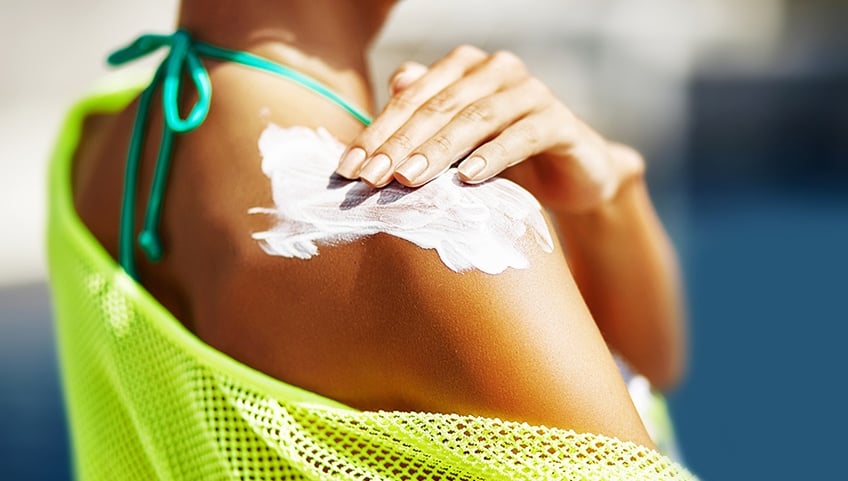
Keeping your skin healthy and damage-free is important for reducing your risk of developing melanoma and nonmelanoma skin cancers. One of the best ways to do that is to prevent sun damage from occurring by using sunscreen. However, many people don't apply sunscreen properly, or they’re making other common mistakes when using sunscreen which is increasing their risks of developing skin cancer.
Four important sunscreen facts that everyone understand are:
- The meaning of the sun protection factor (SPF)
- The types of sunscreen available
- Appropriate times to use sunscreen
- Places you should apply sunscreen that you may not have thought of before
Understanding SPF
There are two types of ultraviolet rays that affect our skin: UVA and UVB. According to the American Cancer Society, UVB is the major cause of sunburn and cancer, making it the more dangerous of the two.
The SPF is a measure of the level of protection offered against "UVB" rays. A higher SPF value determines the amount of UVB radiation that is blocked. SPF 15 blocks about 93 percent of UVB rays and SPF 30 about 97 percent. Sunscreens that have SPF 50 or above have limited additional benefits, so most manufacturers will label sunscreens as "50+".
Related Read: What does SPF mean?
Types of Sunscreen
With a wide variety of choices on the market from various brand names offering non-greasy, non-oily, spray-on and so many more options, it can be hard to find the right type of sunscreen for you. And, you can choose whichever type or brand that you like best, as long as it meets two requirements.
Take a look at the label and look for these two items:
- Sun Protection Factor (SPF): This will give you an idea of the strength of the sunscreen you are about to purchase. Higher SPF values indicate more protection, but the sunscreen still must be applied regularly.
- Broad Spectrum Protection label: This label ensures that the sunscreen will protect you from both UVB and UVA rays. Protection from both types provides better resistance to aging and disease to your skin. Both UVA and UVB rays can contribute to skin cancer and your sunscreen should include protection from both. A sunscreen that does not say “broad-spectrum” only protects skin from UVB (burning) rays.
Avoid Common Mistakes When Using Sunscreen
Avoid some common sunscreen mistakes by using the following guidelines:
- Use sunscreen daily. It’s important to apply sunscreen daily, not just when you are visiting the pool or participating in outdoor sports. Driving or riding in the car, you are exposing your arms and hands to enough UVB rays to cause damage.
- Choose a high enough SPF. The SPF in sunscreen typically ranges from 2 to 100. The American Academy of Dermatology recommends wearing sunscreen with SPF of 30 or higher. Sunscreen rated SPF 30 blocks out 97% of the sun's UVB rays.
- Apply enough sunscreen. Be sure to apply enough sunscreen (two tablespoons, roughly the amount a shot glass holds) to cover the body sufficiently.
- Plan ahead. You should apply sunscreen 15 - 20 minutes before you go outside, so your skin has time to absorb it.
- Reapply sunscreen often. The American Cancer Society recommends that you reapply your sunscreen every 90 minutes to two hours, and even sooner if you are sweating or swimming.
- No sunscreen is completely waterproof or sweat-proof. Many sunscreen bottles say they’re water resistant. That means it will wear off when you get wet. This includes any activities that involve water but sunscreen can also be worn off just by sweating, and these sunscreens have been proven to remain effective for at least 40 minutes while you’re in the water or sweating. Therefore, it is good practice to reapply sunscreen after each time you swim, sweat heavily or dry off with a towel, as sunscreen can be rubbed off.
Sunscreens come in various formulations, including creams, lotions, and sprays. You should first start by finding a sunscreen that works best for your lifestyle. Remember that if you choose a spray sunscreen you should avoid inhaling the spray mist while applying and be sure to rub it in after spraying to be less likely to miss a spot.
Reducing your risk of developing cancer shouldn't just be limited to using sunscreen. Avoiding tanning beds, wearing a large brimmed hat and and limiting sun exposure are some additional ways that can also help reduce your risk of developing skin cancer. In Virginia, UV rays are strongest in late spring and early summer; therefore, be sure to take extra precautions during these months. Learn more about skin cancer risk factors and risk prevention tips from the cancer treatment specialists of Virginia Oncology Associates.
Originally published September 2017. Updated April 2019.
Sources:




